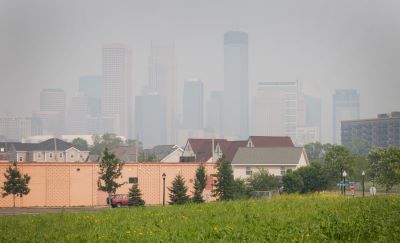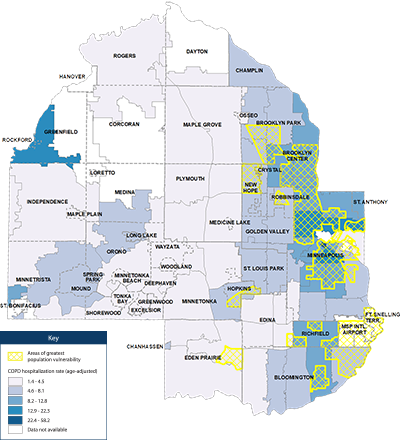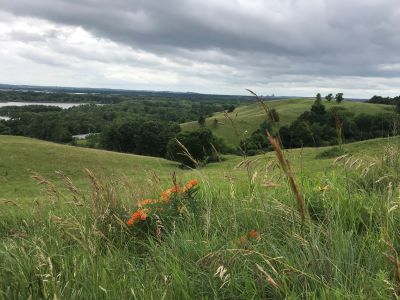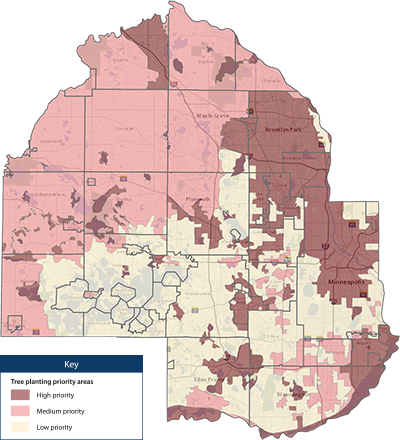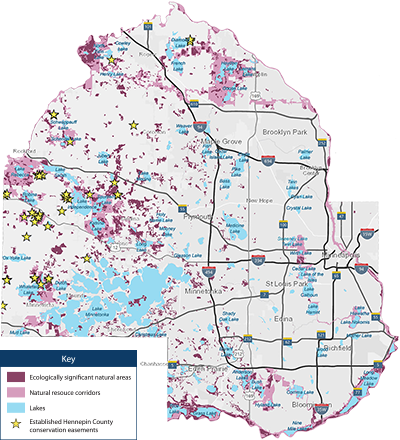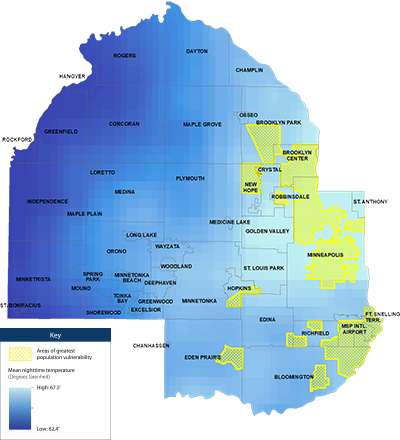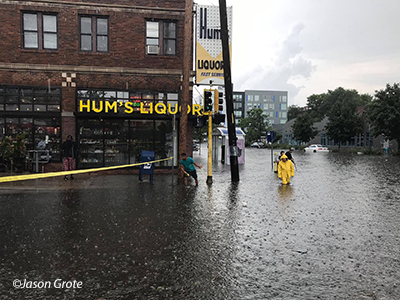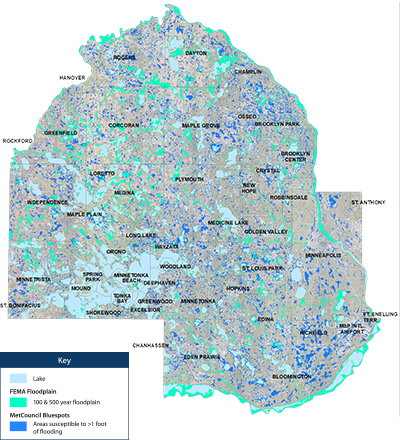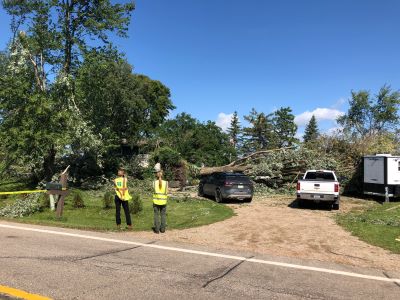|
Air quality Causes and trends
Currently, Hennepin County’s air quality is generally good in terms of meeting federal air quality standards. Air quality has improved in recent years due to several factors. Many power plants have transitioned to using natural gas instead of coal, solar and wind energy has increased, there are more transit options, and fuel economy standards have increased. However, projected climate trends will result in decreased air quality. Impacts and threatsIncreasing levels of air pollution pose threats to those with underlying health conditions such as asthma, chronic obstructive pulmonary disease (COPD), and allergies. The impacts of increased air pollution include: Unhealthy air quality from increasing levels of ozone and particulate matter and more days affected by wildfire smoke. More mold and bacterial growth in buildings due to rising humidity levels and more frequent flooding. Extended allergy season due to rising temperatures and the lengthening of the growing season.
Chronic obstructive pulmonary disease (COPD) hospitalization rates and climate change vulnerabilities
This map shows how the COPD hospitalization rate aligns with where people who are the most susceptible to climate impacts live. The COPD hospitalization rates is used because it is closely correlated with poor air quality. The overlap of the yellow areas and the darker blue areas are where people who face the greatest threats from increasing air pollution live. Who is more at risk Some people are exposed to more air pollution than others because of where they live or work, and some people are more affected by. For example, people with pre-existing heart and lung conditions are at greater risk, and so are the elderly and children. People of color, indigenous people, and people with low incomes face social, economic, and health inequities that often contribute to increased frequency of health conditions that can be affected by air pollution. Air pollution tends to be higher in the parts of Hennepin County where residents who are most susceptible to climate change live because of the higher density of emission sources. For example, transportation-related air pollution is higher in the more urban areas of the county where the road network is densest and traffic is highest. This coincides where many of the residents most susceptible to climate change live. See the Minnesota Pollution Control Agency's Life and Breath report (PDF) for more information on how air pollution affects health in Minnesota.
Air pollution from traffic
This map depicts a projection of air pollution from traffic based on average daily trip data. As would be anticipated, transportation-related air pollution is higher in the more urban areas of the county where the road network is densest and traffic is highest. According to the Minnesota Pollution Control Agency, communities of color bear a disproportionate burden of traffic-related health impacts due to living in proximity to the highest traffic levels.
Close Disruptions to ecosystems Causes and trends These ecosystems are already threatened by invasive species, population growth, and development. Climate change will further disrupt our ecosystems since native wildlife and plants are extremely sensitive to climate change impacts. Threats and impactsWarming lakes, rivers, streams, and wetlands and an increase in algae blooms impact fish habitat and recreation. Our tree canopy already faces many threats from pests, such as the invasive emerald ash borer, and climate change will only worsen those pressures by enabling more pests to survive. A warming climate is also changing the types of plants and trees that can thrive in our area, with northern species struggling while new species adapted to warmer climates start to take their place. Changes in temperature and precipitation patterns will also disrupt the delicate balance of ecosystems and the species that depend on each other. Shifts in food availability, migration timing, and breeding seasons will impact survivability for many species.
Tree planting priority areas
The county’s tree planting priorities map factors in both environmental and demographic data to understand areas that have lower tree canopy and higher need. Information used includes land cover data and disparity data such as income, housing, and health. Darker areas the highest priority for tree planting due to lower tree canopy cover and greater disparities. Who is most at risk Healthy ecosystems play a vital role not only in the health of plants and animals, but of people, too. The trend toward a wetter climate has already added uncertainty and increased the challenge of producing food in a rapidly developing county. Working with residents to preserve open space and improve agricultural practices represent some of the best opportunities to sequester carbon, manage increased precipitation, connect habitats, and improve access to nutritious, locally produced food. However, the added business risks that climate change poses to farmers will make it increasingly challenging to realize those benefits, and the incentives to develop open space will only increase.
Natural areas in Hennepin County
Hennepin County has a diversity of habitats, including forests, prairies, oak savannas, wetlands, and lakes. The remaining natural areas in the county are important for capturing carbon, providing habitat for wildlife, and improving our collective well-being. But these natural areas are threatened as development pressure increases, making it critical to protect these areas now. This map helps to guide priorities for protecting natural areas in Hennepin County. The darker areas on the map are ecologically significant natural areas, which are areas of unique, high-quality ecosystems and habitat. Natural resources corridors. shown in lighter purple, help to connect natural areas and allow for movement of wildlife. The stars are established conservation easements in the county, which are areas of private land that are permanently protected. The county's goal is to acquire 6,000 additional acres of conservation easements by 2040.
Close Extreme heat and cold Causes and trends
Extreme heat, especially in urban areas, will disproportionately affect residents with underlying health conditions, especially those with limited means to adapt. Who is more at riskThe capacity to respond to increasing temperatures determines whether heat is an inconvenience, a manageable problem, or a catastrophic event. For many residents, higher temperatures may translate only to higher utility bills resulting from increased use of air conditioning. But some residents may not have air conditioners or the ability to pay to run them and are more likely to have underlying health conditions that make lack of access to air conditioning a bigger problem. Many cooling centers are not open overnight or are not reasonably available to those in need. This is problematic because the inability for the body to cool off, especially at night, exacerbates physical and mental health stressors. This is especially true for residents living in urban areas. Many urban areas have more concrete and other impermeable surfaces that radiate heat along with less tree canopy and greenspace to mitigate the heat. This creates urban heat islands where the temperature measured can be significantly higher than the official reported temperature. The continued rise of temperatures due to climate change is likely worsening this heat island effect.
Urban heat island
This map was developed using average August nighttime mean temperatures from August 2011 to August 2014. Nighttime temperatures are an important factor because our bodies are evolved to cool down at night. The lighter blue areas correspond with higher temperatures. Temperatures in the urban Twin Cities core averaged 2 degrees F higher than surrounding areas and spiked to as much as 9 degrees F higher than surrounding areas during a heat wave. The yellow areas are where people who are the most susceptible to climate impacts live. The overlap shows that people who are most susceptible to the impacts of climate change also experience stronger heat island effect. To illustrate how climate change compounds other issues, a separate analysis by the University of Minnesota showed that the areas most impacted by the urban heat island effect align with areas where people who have historically faced housing discrimination live.
Close Flooding and water quality Causes and trends
Heavy rainfall contributes to increased flash flooding. Sustained high levels of precipitation can increase groundwater flooding, and higher groundwater levels pose threats to water quality. In addition, warmer winters have led to an increase in freeze/thaw events. Impacts and threatsIncreased flooding events can endanger lives, destroy property and belongings, disrupt vital services, and hinder the ability of emergency response vehicles to respond to calls. Buildings in persistently saturated soils are more likely to grow mold and bacteria that reduce indoor air quality and pose respiratory threats to people in the buildings. Rising groundwater levels may pose a risk to local water quality when it intersects with septic systems, petroleum tanks, areas of historic contamination, plumes, and vapors. Increases in freeze/thaw events negatively impact pavement systems and accelerate infrastructure deterioration. Who is more at riskThe ability of property owners and residents to respond and recover from flood impacts varies greatly. For some residents and businesses, flooding may be an inconvenience or a manageable problem. For others, such as a small business or a low-income family, flooding is potentially catastrophic. Beyond property damage, flooding also can lead to mold-related health impacts, waterborne diseases, and stress. Saturated soils disproportionately impact residents living and working in areas prone to groundwater flooding. These residents may not realize they are at risk. Until recently, those getting flood insurance were mostly property owners and residents in Federal Emergency Management Agency (FEMA)-designated floodplains. Recently with the increasing frequency and intensity of heavy rainfall, nearly one-quarter of flood damage and one-third of flood recovery costs occur outside of the FEMA-designated floodplains, making it clear that wherever it can rain, it can also flood.
Areas susceptible to flooding
The locations on this map in dark blue are low spots identified by the Met Council that are susceptible to localized flash flooding from high-intensity rainfall based on topography. This analysis was conducted, in part, to examine risks from localized flooding that FEMA mapping (identified in teal) doesn’t consider. This Met Council “Blue Spot” data does not consider the varying capacity of these locations to drain, either through stormwater drains or soil infiltration. However, most stormwater conveyance systems were designed based on outdated precipitation models, meaning these areas are likely at risk for flash flooding.
Close Mental health and well-being Some people may experience sudden mental health impacts after experiencing a weather disaster, while other impacts will be gradual and cumulative. According to the Minnesota Department of Health, each person will react to climate change differently based on a variety of factors such as where they live, their occupation, and previous significant interactions with disasters and their environment. Climate is also fundamental to our understanding of place. Here in Minnesota, discussing the weather is a favorite pastime and the changing seasons provide a signal for certain recreation and economic activities, such as the ice fishing season, planting and harvesting times, and tourism to ski areas. Our attachment to places — the environments, traditions, and customs tied to these places — are an important part of our identity. This attachment to place is what makes environmental changes and natural disasters particularly distressing. Sense of lossThe Minnesota Department of Health identifies an emerging concern for a psychological phenomenon called ‘Solastalgia’ - a newer concept developed to give greater meaning and clarity to environmentally induced distress. Solastalgia is characterized by a sense of distress or emotional pain felt when the place of solace (or homeland) is diminished or destroyed. Climate change can contribute to several sources of loss that may include: Loss of habitat for native plants and wildlife Water shortage and drought Loss of livelihood for those who have a career dependent on stable and expected climate conditions Loss of property, pets, or possessions due to a disaster Loss of place due to forced migration or displacement due to a disaster or loss of job All of these losses can cause stress, sadness, anxiety, or depression amongst individuals that are impacted. When the county surveyed residents about impacts of climate change that they’ve experienced in the past few years, the most common response was stress or anxiety about climate change. See the survey report (PDF) for more information. Climate anxiety among youthYouth are increasingly reporting climate anxiety, and interventions are needed to foster resiliency. Parents and educators can be influential in shifting feelings of powerlessness in the face of the climate crisis to actions to take to gain a sense of control. The Minnesota Department of Health recommends the following strategies: Help youth understand the links between actions and impacts on ecosystems and environmental resources. Ask youth how climate change and related natural disasters make them feel. Take time to address feelings and help youth find healthy, proactive ways to reduce negative thoughts and gain a sense of control. Learn moreThe Minnesota Department of Health has numerous resources on climate and well-being, including more information about the health outcomes, at-risk populations and resources available to help. Yale Climate Connections shares an insightful article on how to talk with kids about climate change. Climate Generation, a Minnesota-based non-profit organization, is a leader in climate education and offers resources and trainings for educators, as well as opportunities for youth to get involved in advocating for collective action on climate.
Close Increases in diseases from ticks and mosquitoes When talking to residents, employees, and other partners during the development of the Climate Action Plan, nothing got people's attention faster than mentioning an increase in ticks and mosquitoes. Not only are these pests annoying to Minnesotans looking to enjoy a short summer season in our great outdoors, but these pests can cause serious diseases in people and pets. According to the Minnesota Department of Health (MDH), climate is one of many important interacting variables that affect people’s risk for vector-borne diseases. MDH expect the distributions of ticks, mosquitoes, and other insects to change as a result of warmer and wetter conditions, and increased transmission is expected with West Nile Virus, La Crosse Encephalitis, and Lyme disease. Understanding how Minnesota’s changing climate may alter vector-borne disease risks currently and into the future is important work for public health agencies. The Climate Action Plan calls for collecting data and monitoring climate risks to public health, including changes in vector-borne diseases. Staff will also improve education and communication to promote awareness, personal action, and best practices. Learn more (责任编辑:) |

